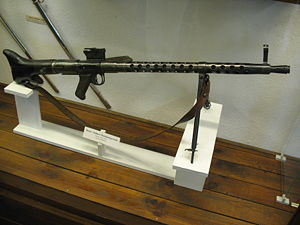- MG 30
-
MG 30
The MG 30 on display in Austria.
(Festung Hohensalzburg)Type Machine gun Place of origin  Austria,
Austria,  Switzerland
SwitzerlandService history In service 1930's–1940's Used by See Users Production history Designer Louis Stange Manufacturer Steyr-Daimler-Puch Variants MG 15, MG 17 (Both used in aircraft) Specifications Weight 12 kg (26 lb) Cartridge 8x57mm IS, 8x56mmR 31.M, 7x57mm Mauser (47 ordered in this caliber by El Salvador) Caliber 7.9mm Action Recoil Rate of fire 600–800 RPM Muzzle velocity 807.92 m/s (2,650 ft/s) Feed system 30-Round magazine, 25-Round magazine (8x56R) The Maschinengewehr 30, or MG 30 was a German-designed machine gun that saw some service with various armed forces in the 1930s. It was also modified to become the standard German aircraft gun as the MG 15 and MG 17. It is most notable as the design pattern that led to the MG 34 and MG 42, and thus is one of the major ancestors of many of the weapons in service which would later find widespread use into the 21st century.
Contents
History
Development of the MG 30 took place under the direction of Louis Stange at Rheinmetall's Sömmerda office. However actual production of machine guns was prohibited in Germany under the Versailles Treaty, and the design was rejected by the Reichswehr. Rheinmetall then turned to other companies and licensed the design to Solothurn in Switzerland and Steyr-Daimler-Puch in Austria. Production soon followed, entering the armed forces of both countries as the Solothurn S2-100 and Maschinengewehr Solothurn 1930, or MG 30, respectively. 2000-3000 were also purchased by Hungary, where it was known as the Solothurn 31.M Golyoszoro.
Design
The gun is an air-cooled, recoil-operated design, firing standard 7.92x57mm Mauser ammunition, fed from a slightly curved 30-round magazine inserted in the left side of the weapon. It uses a locking ring, which is located at the end of the barrel extension, to lock the bolt. Inside the locking ring, there are six sets of locking lugs, arranged as an interrupted thread, which mate with lugs cut at the rear of the bolt. Rotation of the ring, which locks and unlocks the bolt, is controlled by rollers mounted on the outside of the ring. Upon recoil, these rollers follow cam tracks cut into the receiver. The gun is of relatively simple design, with most parts having a round cross-section. The tubular receiver is an extension of the barrel jacket. The butt hosts a tube which contains the return spring and its guide.
The MG 30 fired both in semi-automatic and full automatic mode depending on how far the two-stage trigger is pulled, with a rate of fire between 600 and 800 rounds per minute in full-auto. It included a folding bipod attached two thirds down the barrel.
Variants
Rheinmetall's Borsig office modified the MG 30 design for use as an aircraft gun, producing the Flugzeugmaschinengewehr 15, or MG 15. The primary changes were the use of a double-drum magazine holding 75 rounds, and the removal of the stock for use inside the cramped quarters of a bomber.
Further modification in 1936 led to the MG 17, which included provisions for belt-fed ammo in addition to the drums, increased the rate of fire to about 1,200 rpm, and was suitable for use with an interrupter gear for shooting through the aircraft's own propellor.
In 1942 aircraft guns had increased dramatically in size, and the 7.92 mm weapons were no longer considered useful by the Luftwaffe. Many were then sent to the army, who started a program to modify them into ground-based weapons by adding a bipod and simple metal stock.[clarification needed]
Statistics
- Caliber: 7.9 mm
- Load: 50 round beltless saddle drum
- Action: select fire, air-cooled
- Rate of Fire: 600 to 800 rpm
- Weight: 27 lb (12 kg)
Users
References
See also
- MG 34, direct successor of MG 30.
- Kg/1940 Light machine gun
- MG 42, successor of MG 34 still largely based on original MG 30.
- MG 81 machine gun
- MG 3, successor of MG 42.
- MG 710, Also known as MG 55.
- Rheinmetall
- Steyr-Daimler-Puch
- Weapons employed in the Slovak-Hungarian War
German firearms and light weapons of World War IISide arms (Pistolen) Mauser C96 · Luger · Walther P38 · Walther PP and PPK · Sauer 38H · Mauser HSc · Dreyse M1907 Pistol · VolkspistoleRifles & carbines (Gewehre & Karabiner) Karabiner 98k · G 24(t) · G 33/40(t) · G 98/40 · Gewehr 41 · Gewehr 43/Karabiner 43 · MP 43/MP 44/StG 44 · FG 42 · M30 Luftwaffe drilling · StG 45(M) · VG 1-5 · Wimmersperg Spz-krSubmachine guns (Maschinenpistolen) Machine guns & other larger weapons MG 08 · VMG-27 · Schwarzlose MG M.07/12 · MG 13 · MG 15 · MG 26 · MG 30 · MG 34 · MG 42 · MG 45 · IMG 28 · MG 35/36A · Faustpatrone · Raketen-Panzerbüchse 43 · Panzerfaust · Panzerschreck · Fliegerfaust/Luftfaust · Flammenwerfer 35 · Einstossflammenwerfer 46 · Panzerbüchse 39 · Solothurn S-18/1000Mortars (Granatwerfer) Grenades (Granaten) Notable foreign-made infantry weapons German-made cartridges used by the Wehrmacht 8×57mm IS · 7.63×25mm Mauser · 8x33mm Kurz · 7.65×22mm Parabellum · 9×19mm Parabellum · 13.2×92mmSR · 7.92×94mmCategories:- Light machine guns
- World War II German infantry weapons
- 8 mm machine guns
Wikimedia Foundation. 2010.

